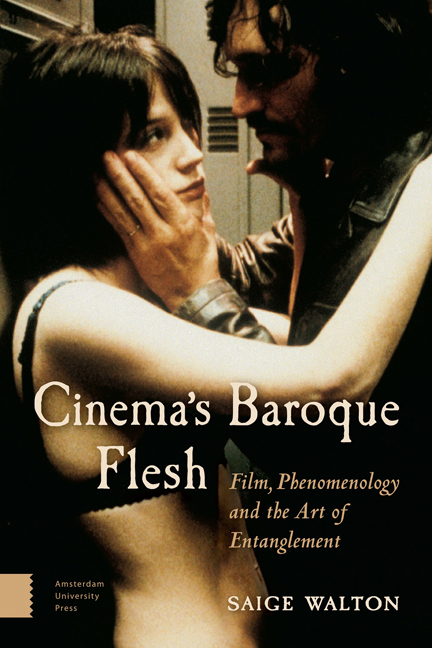Book contents
- Frontmatter
- Dedication
- Contents
- Acknowledgements
- Introduction
- 1 Flesh, Cinema and the Baroque: The Aesthetics of Reversibility
- 2 Knots of Sensation: Co-Extensive Space and a Cinema of the Passions
- 3 Baroque Skin/Semiotics
- 4 One Hand Films the Other: Baroque Haptics
- Conclusion: Or the Baroque ‘Beauty of the Act’
- Notes
- Bibliography
- Filmography
- Index
- Frontmatter
- Dedication
- Contents
- Acknowledgements
- Introduction
- 1 Flesh, Cinema and the Baroque: The Aesthetics of Reversibility
- 2 Knots of Sensation: Co-Extensive Space and a Cinema of the Passions
- 3 Baroque Skin/Semiotics
- 4 One Hand Films the Other: Baroque Haptics
- Conclusion: Or the Baroque ‘Beauty of the Act’
- Notes
- Bibliography
- Filmography
- Index
Summary
This baroque world is not a concession of mind to nature; for although meaning is everywhere figurative, it is meaning which is at issue everywhere. This renewal of the world is also mind's renewal, a rediscovery of that brute mind which, untamed by any culture, is asked to create culture anew.
– Maurice Merleau-Ponty (‘The Philosopher’, p. 181; italics mine)In his book The Fold: Leibniz and the Baroque, philosopher Gilles Deleuze extends the formal and critical reach of the baroque beyond historic confines. Detaching the baroque from its traditional historic, geographic, and artistic origins in seventeenth-century Europe, Deleuze argues that the baroque is best understood as a restless trans-historic ‘operative function, a trait. It endlessly produces folds’ (The Fold, p. 3). If the baroque can be extended into the twentieth and twenty-first centuries, I ask: What is the relationship between cinema and the baroque? How might it be figured and felt in film?
As we shall discover, Deleuze's philosophy of the fold is one possible means for us to engage with the baroque's vast and complex critical territory. This book explores the baroque as its own aesthetic category of film, one that generates its own cinema of the senses. Rather than the fold, it is in the writings of Maurice Merleau-Ponty that Cinema's Baroque Flesh: Film, Phenomenology and the Art of Entanglement finds its titular inspiration. The baroque of art and film spurs an aesthetic concretization of what Merleau- Ponty likes to call ‘flesh’. Foregrounding the baroque as a vital undercurrent of Merleau-Ponty's phenomenological thought, what I name baroque flesh is a productive site of analysis and it is the main film-philosophical model by which I approach all of the films examined here.
Like Deleuze's articulation of the baroque-as-fold, Merleau-Ponty also demonstrates a pliant, embodied, and suitably trans-historic appreciation of the baroque. In the quotation that begins this book, he gestures towards the possibility of a ‘baroque world’ in which its overall ‘configurational meaning […] is in no way indicated by its “theoretical meaning”’ (‘The Philosopher’, p. 181).
- Type
- Chapter
- Information
- Cinema's Baroque FleshFilm, Phenomenology and the Art of Entanglement, pp. 11 - 28Publisher: Amsterdam University PressPrint publication year: 2016



